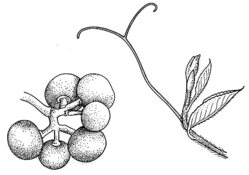
Description: Woody climbers. Tendrils simple or 2-branched at apex, adhesive discs absent.
Leaves simple or more commonly palmately 3–5-foliolate with lateral leaflets smaller than terminal one, margins toothed to entire; domatia present on lower surface (excpt A. hypoglauca).
Cymes compact to loose, leaf-opposed, main branches, ± umbellate; usually long-peduncled. Flowers bisexual, usually 4-merous. Calyx entire or shortly toothed. Petals free at maturity, apex hooded. Disc cupular, fused to base of ovary, 4-lobed. Ovary 2-locular, each loculus with 2 ovules; stigma small.
Berry 1–4-seeded.
Distribution and occurrence: A genus of seven species, five in Australia, two in New Guinea (one shared with Australia), one species disjunct in central South America.
Previously included in the large genus Cissus, but most species can be distinguished by the presence of puch-like domatia on the lower leaf surface. All NSW species previously included in Cissus are now placed in Apocissus.
Text by R. L. Barrett, January 2025
Taxon concept: Jackes, B.R. & Trias-Blasi, A. (2023). Apocissus Jackes & Trias-Blasi, a new genus in the Vitaceae. Austrobaileya 13: 94–104.
| | Key to the species | |
| 1 | Leaves simple with both domatia and prominent stipules2 | |
| Leaves compound, usually 3–5-foliolate, with either prominent stipules or domatia | 3 |
| 2 | Leaves usually hairy below, hairs distinctly stalked, margins with some serrations. Flowers in compact umbels | Apocissus antarctica |
| Leaves soon glabrescent below, hairs closely adpressed, margins usually entire. Flowers in loose umbels
Back to | Apocissus oblonga |
| 3 | Leaves with prominent domatia, stipules absent | Apocissus sterculiifolia |
| Leaves without domatia, stipules present
Back to 1 | 4 |
| 4 | Leaflets usually 5–10 cm long, rounded at base and borne on distinct petiolules; young shoots rusty-hairy | Apocissus hypoglauca |
| Leaflets mostly 1–6 cm long, tapering into short petiolules or sessile; young shoots more or less glabrous
Back to 3 | Clematicissus opaca |
|


